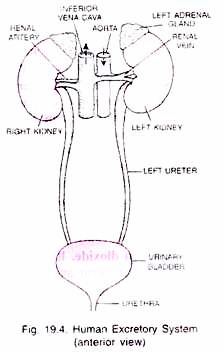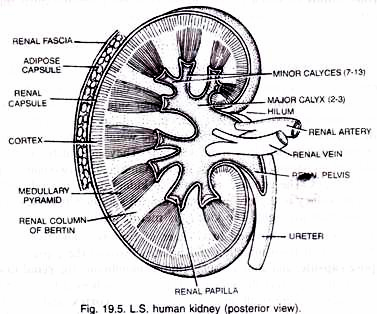The following points highlight the four types of human excretory system. The types are: 1. Kidney 2. Ureters 3. Urinary bladder 4. Urethra.
Human Excretory System: Type # 1. Kidney:
There is a pair of kidneys which are dark-red, bean shaped, each with a notch, (concavity), the hilus (= hilum) on its inner side. Blood vessels, lymph vessels, nerves and ureter enter or leave the kidney through the hilus. Each kidney is about 11 cm long 5 cm wide and 3 cm thick. In the adult male the weight of the kidney averages about 150 gms. and in the adult female it is about 135 gms.
They are situated in the anterior part of the abdominal coelom one on either side of the median line. Last two pairs of ribs (floating ribs) protect the kidneys. The concave side of each kidney faces inwards and convex side outwards. The right kidney is slightly lower than the left and the left kidney is a little nearer to the middle plane than the right. The kidney is metanephric.
The kidney is covered by a layer of fibrous connective tissue, the renal capsule, which protects it from infection and injuries. Around the capsule there is a layer of fat, the adipose capsule, and another outer fibrous membrane, the renal fascia.
Both the fat and the fascia help to protect the kidney. The fascia anchors it to the abdominal wall. Inner to the renal capsule there is an outer dark region, the cortex, and inner lighter region with a striated appearance, the medulla.
The medulla is divided into a number of conical areas, the medullary pyramids (15 or 16) having their broad base towards the cortex. Each renal medullary pyramid terminates into a structure, the renal papilla. Between the medullary pyramids the substance of the cortex extends into the medulla and forms the renal columns of Bertin. The medullary pyramids are connected with minor calyces (7—13).
The minor calyces (sing, calyx) lead into major calyces (2-3). A human kidney possesses two to three major calyces. The latter open into a funnel shaped structure, the renal pelvis which in turn leads into the ureter. A kidney has about ten lakh structural and functional, units called nephrons or uriniferous tubules. Structure of a nephron is described later.
Human Excretory System: Type # 2. Ureters:
The ureter of each kidney leaves from the renal pelvis in the hilus region. Each ureter is about 25 to 30 cm in length. They are narrow, whitish, tubular structures, running backward along the abdominal wall to open into the urinary bladder. Ureters are composed of transitional epithelium. They carry urine from the kidneys to the urinary bladder.
Human Excretory System: Type # 3. Urinary Bladder:
It lies in the pelvic cavity and is somewhat pear shaped, muscular, sac-like structure. Its inner lining is composed of transitional epithelium. The muscular layer of the urinary bladder is well developed and is called detrusor muscle. The latter consists of three layers of smooth muscle— inner and outer layers of longitudinal fibres and middle layer of circular fibres.
In the area where the bladder and urethra join some of the circular smooth muscle is modified to form the internal sphincter (part of detrusor muscle). Inferior to the internal sphincter is an external sphincter made of skeletal muscles which is under voluntary control of the nervous system. Both the sympathetic and parasympathetic nervous systems innervate the urinary bladder.
Internally, the urinary bladder has a triangular area, the trigone, between the three openings— two openings through which the ureters enter the bladder and one opening through which the urethra leaves the bladder. The urinary bladder stores urine temporarily.
Human Excretory System: Type # 4. Urethra:
It is a canal like structure which extends from the neck of the bladder and leads to exterior. Its length differs in the male and female. In female, urethra is short (about 4 cm in length) and carries only urine.
It opens by urethral orific (urinary aperture) in-front of vaginal aperture (genital aperture). In male, urethra is much longer (about 20 cm in length) which opens out at the tip of the penis by urinogenital aperture. Thus the urethra of male carries both urine and semen (Fig. 19.6).


